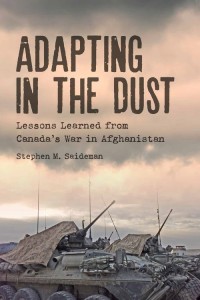“Was it worth it?” Prof. Stephen Saideman asks of the Afghan War. The question is poignant if unanswerable. It took deathbed memoirs and archival disclosures to reveal the whole story of the First World War some forty years after the fact, and inside scoops are still a hot item for historians.
Today, only two years after the withdrawal of Canadian troops, we are resigned to self-serving platitudes of participants with a deep personal investment in claiming victory. “There is a buzz in the air these days in Afghanistan, a sense of optimism,” Deborah Lyons, Canadian ambassador to Kabul, wrote in a 2015 blog entry; “I think we all feel it.”
The military last year released a Post-Operations Report that enthused the number of local cellphone subscribers had nearly doubled from 12 million to 20 million, and that Afghanistan now presumably has better wireless coverage than northern Manitoba. This is not why we spent $20 billion and suffered more than a thousand casualties. Post-Operations Report failed to note opium remains the mainstay of Afghanistan’s economy, and the official unemployment rate is 35 percent.
Adapting In The Dust is a pointed addition to the first wave of literature that examines whether we should have been in Afghanistan at all. “In the collective mind of senior officers the Afghanistan effort was a major success,” writes Prof. Saideman, Paterson Chair in International Affairs at Carleton University; “Nearly every Canadian who commanded in Afghanistan has been promoted.”
Indeed. The best-known chief of the defence staff, General Rick “Hell-ya” Hillier, gave himself a $250,000 retirement send-off that included a farewell ride in a tank. Cabinet in 2006 had deployed a squadron of 17 military surplus Leopard tanks to Afghanistan. It cost $189 million. Only on arrival in the desert did commanders note the vehicles had no air conditioning, and that interior temperatures hit 60°. The question of who deploys tanks in a guerrilla war remains unanswered.
“I heard one senior NATO officer say that he had more than 60 different metrics of success, which means that he did not really have a single good one,” Saideman writes; “It may very well be the case that many of the things that Canada did during its time in Kandahar will dissipate. The schools may close, the roads may fall into disrepair, and the Taliban may have more than a few successes. So Canadians may wonder whether it was all worthwhile.”
Interestingly, Adapting In The Dust concludes it was. “We can cloud the issue by talking about schools, vaccinations, and the like, but the reality is that Canadian leaders – three of them, from two political parties – sent troops into harm’s way because of Canada’s place in the world,” says Saideman. “We can look at the conflicting progress reports about what was achieved in Afghanistan, but the mission always was about Canada’s commitment to its allies.”
Our Asian land war was messy and confused. The mere decision to send troops into combat was made in a closed-door meeting with participants, including Hillier, who’d never been to Afghanistan – I can find no evidence Hillier ever traveled farther west than Fort Hood, Texas –and later published conflicting accounts of their discussion.
“It is clear that Canada was not ready for a mission as intense and as complex as Afghanistan,” Saideman concludes. “The question now is whether and how Canada adapted during the conflict so that it will be better equipped the next time.”
Of course we’ll find the whole answer – in about forty years, with deathbed memoirs and archival disclosures.
By Tom Korski
Adapting In The Dust: Lessons Learned from Canada’s War in Afghanistan, by Stephen M. Saideman; University of Toronto Press; 184 pages; ISBN 9781-4426-14734; $19.95






